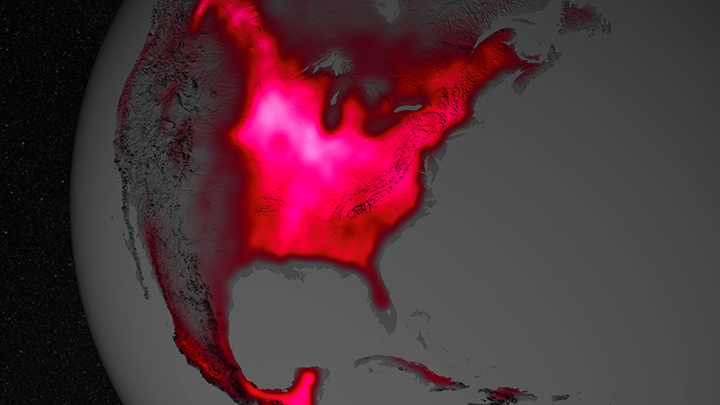
The magnitude of fluorescence portrayed in this visualization prompted researchers to take a closer look at the productivity of the U.S. Corn Belt. The glow represents fluorescence measured from land plants in early July, over a period from 2007 to 2011.
Editor’s Note: This is an excerpt from the NASA Science in the News column published in the May/June issue of the Earth Observer. You can download the current issue of the newsletter here.
Under the Summer Sun, the Corn Belt Is the Most Biologically Productive Place on Earth, Smithsonian Magazine. Rainforests, whether in the Amazon, Southeast Asia, or Central America, are hotspots of organic productivity. Fueled by abundant rain and a reliable stream of nutrients, the Amazon blooms year-round. For a brief period each summer, however, the ingenuity of humankind trumps even the mighty rainforests at biological production. A group of researchers, including Christian Frankenberg and Joanna Joiner have determined that during peak growing season, the Midwest U.S. Corn Belt is the most productive land on Earth. In other words, there’s more photosynthesis going on here than in the Amazon. When plant cells photosynthesize, part of the energy they produce is emitted as fluorescent light. By measuring the strength of this fluorescence from space, scientists can get a measure of plant productivity.
Arctic Melting Is Lasting Longer and Affecting More Ice, UniverseToday.com. The Arctic melt season is averaging five days longer with each passing decade, a new study by NASA and the National Snow and Ice Data Center reveals. More ice-free days mean the water (which is darker than the surrounding ice) is exposed longer and can absorb more of the Sun’s heat, further increasing the melting rate and extent. The study shows that thickness of the Arctic ice cap has shrunk by as much as 1.2 meters (4 feet). By the end of this century, scientists believe the Arctic Ocean will be ice-free during the entire summer. This news came in the same week that the Intergovernmental Panel on Climate Change released its own report on global warming. Data were collected with NASA’s (long-deceased) Nimbus-7 Scanning Multichannel Microwave Radiometer and instruments onboard Defense Meteorological Satellite Program spacecraft. Scientists can measure the changes in the ice’s microwave emissivity using a formula developed by co-author Thorsten Markus.
NASA Study Projects Higher Temperatures Despite Recent Slowdown in Global Warming, Bloomberg. Despite a recent slowdown in the rate of global warming, a study by Drew Shindell suggests global temperatures will likely continue to rise in coming decades, on track with earlier estimates of increasing temperatures. Shindell and his colleagues sought to reconcile different estimates for the Earth’s climate sensitivity, or how temperatures change in response to changes in radiative forcing. Some studies estimate low climate sensitivity, based on the assumption that global average temperatures would respond uniformly to increases of carbon dioxide (CO2) and other greenhouse gas emissions. But the NASA study showed that global temperatures are more sensitive to changes in aerosols and ozone in the atmosphere than was thought. This higher sensitivity could mean a larger and faster temperature response. Shindell said the study’s findings could have “a really profound impact” on the amount of greenhouse gas emission reductions needed for countries to meet an international goal of limiting temperature increases to 2°C (3.6 °F). “I wish it weren’t so,” said Shindell, “but forewarned is fore-armed.” Global temperatures have increased at a rate of 0.12 °C (0.22 °F) per decade since 1951, according to the NASA GISS temperature record. This trend has been interrupted since 1998, as since then the rate of warming has slowed to only 0.05 °C (0.09 °F) per decade—even as atmospheric CO2 continues to rise.
Amazon Rainforest Breathes In More Than It Breathes Out, LiveScience.com. A new study further confirms that pristine Amazon forests pull in more CO2 than they put back into the atmosphere, helping to reduce global warming by lowering the planet’s greenhouse gas levels. When scientists account for the world’s CO2, their totals suggest some of the greenhouse gas disappears into land-based carbon traps. These natural carbon sinks, such as forests, absorb and store CO2, helping to lower the greenhouse gas levels in the atmosphere. To better measure the carbon flux from the Amazon, researchers tracked tree death throughout the Amazon. Lead study author Fernando Espírito-Santo combined satellite data, airborne lidar data (i.e., laser surface imagery), and tree counts to compare carbon consumed by living trees with emissions from dead trees. Espírito-Santo found that dead Amazonian trees emit an estimated 1.9 billion tons (1.7 billion metric tons) of carbon to the atmosphere each year. In a normal year, the Amazon rainforest absorbs about 2.2 billion tons (2 billion metric tons) of CO2, studies suggest. The study also found that big storms that can blow down millions of trees at once barely budge the forest’s carbon output.




this helps me with my science project big time